Retro mod, moody, and hypnotic -- take a sonic dip in exotic waters
4.75/5.0




 Cosmically speaking, three and half years is the tiniest of intervals. Halley’s Comet takes around 75 years to swing by, so a three to four year pause between Dengue Fever releases should be bearable. But given the hothouse worlds that bands live in, the anticipation can be challenging. Last time around, 2011’s Cannibal Courtship (review) reassured fans that the group hadn't turned away from their Khmer rock foundation, even if they had added bits of funk, ska, and soul. Now Dengue Fever is back with The Deepest Lake, and they continue to refine their playing, this time emphasizing the spy music and cocktail aspects of their sound.
Cosmically speaking, three and half years is the tiniest of intervals. Halley’s Comet takes around 75 years to swing by, so a three to four year pause between Dengue Fever releases should be bearable. But given the hothouse worlds that bands live in, the anticipation can be challenging. Last time around, 2011’s Cannibal Courtship (review) reassured fans that the group hadn't turned away from their Khmer rock foundation, even if they had added bits of funk, ska, and soul. Now Dengue Fever is back with The Deepest Lake, and they continue to refine their playing, this time emphasizing the spy music and cocktail aspects of their sound.
Of course, any time you run into old friends again, you compare them against your memory for changes, and the band takes advantage of that to prank their fans a bit. The opening track, “Tokay”, kicks off with a drum machine and synths laying down a Latin dance vamp. The ten measures intro is long enough that I started to wonder if the band had reinvented themselves. But when Chhom Nimol started singing, the keyboards tag-teamed out to let Zak Holtzman’s tremolo heavy guitar come in, connecting with the group's canonical style. Senon Williams still revels in his Latin-flavored bassline and the percussion includes cuíca accents, but that all fits perfectly with the familiar sounds of Nimol’s haunting voice, echo laden guitars, and Ethan Holtzman’s moody organ solo.
After “Tokay” teases, “No Sudden Moves” offers a strong taste of what The Deepest Lake is all about. The mod, mid ‘60s cocktail vibe is Dengue Fever a go go. Tight horns harmonize the twisting guitar riff and a bass sax blatts out the punches. The chorus softens the edges with sweet pulsing guitar winding around the vocals. The bridge interlude veers forward in time, kicking off with an angular new wave guitar pattern, setting up a slinky bassline to accompany Nimol’s staccato Khmer rap. Then the band drifts into a spy soundtrack interlude to recapture the mod flow of the song and take it home.
That hip retro feel continues through The Deepest Lake, meshing well with the reflective tone of reverb-soaked guitar and hypnotic bass. Nimol’s voice is born for this milieu, sexy and seductive, somehow creating understanding, even if most of the lyrics are in Cambodian. While these songs share DNA with earlier tunes, the group seems to be branching out a bit to explore other cultures. “Ghost Voice” features a distinctly Nigerian guitar, even though the other instruments are anchored in Asian tonality and “Still Waters Run Deep” has an infectious upbeat rhythm that blends Bollywood with “Spy Who Loved Me” chic.
Not all of these tunes are completely new; two were featured on the Girl From the North EP that came out just over a year ago (review). “Taxi Dancer” and “The Deepest Lake on the Planet” are just as good here, but The Deepest Lake is full of great tracks. Probably the best one is “Rom Say Sok”, which features Zac and Nimol’s vocal chemistry and draws on the psychedelic soul the band toyed with on Cannibal Courtship. I can’t help but picture “it” girls doing the frug as the tune spins out. Although this is one of the few songs here with mostly English lyrics, they're trippy and oblique, “French boyfriend will never be wed / Alligator's dried up and now it's dead.” The lines may not form a coherent narrative, but the heady music plays along, with tweedly organ and cool little feedback echoes in the margins. A little over halfway through the tune, the horns come in and pump up the soul to lay down the groundwork for David Ralicke’s raging sax solo.
The Deepest Lake proves that Dengue Fever still have their fingers on the exotic, cross-cultural pulse that has inspired them since the beginning. There are precious few truly original bands out there, and I’m glad to hear that one of my favorites is keeping the faith. We may need to wait another three years for the next album, but this one will tide us over till the comet swings by again.
4.75/5.0





 Cosmically speaking, three and half years is the tiniest of intervals. Halley’s Comet takes around 75 years to swing by, so a three to four year pause between Dengue Fever releases should be bearable. But given the hothouse worlds that bands live in, the anticipation can be challenging. Last time around, 2011’s Cannibal Courtship (review) reassured fans that the group hadn't turned away from their Khmer rock foundation, even if they had added bits of funk, ska, and soul. Now Dengue Fever is back with The Deepest Lake, and they continue to refine their playing, this time emphasizing the spy music and cocktail aspects of their sound.
Cosmically speaking, three and half years is the tiniest of intervals. Halley’s Comet takes around 75 years to swing by, so a three to four year pause between Dengue Fever releases should be bearable. But given the hothouse worlds that bands live in, the anticipation can be challenging. Last time around, 2011’s Cannibal Courtship (review) reassured fans that the group hadn't turned away from their Khmer rock foundation, even if they had added bits of funk, ska, and soul. Now Dengue Fever is back with The Deepest Lake, and they continue to refine their playing, this time emphasizing the spy music and cocktail aspects of their sound.Of course, any time you run into old friends again, you compare them against your memory for changes, and the band takes advantage of that to prank their fans a bit. The opening track, “Tokay”, kicks off with a drum machine and synths laying down a Latin dance vamp. The ten measures intro is long enough that I started to wonder if the band had reinvented themselves. But when Chhom Nimol started singing, the keyboards tag-teamed out to let Zak Holtzman’s tremolo heavy guitar come in, connecting with the group's canonical style. Senon Williams still revels in his Latin-flavored bassline and the percussion includes cuíca accents, but that all fits perfectly with the familiar sounds of Nimol’s haunting voice, echo laden guitars, and Ethan Holtzman’s moody organ solo.
After “Tokay” teases, “No Sudden Moves” offers a strong taste of what The Deepest Lake is all about. The mod, mid ‘60s cocktail vibe is Dengue Fever a go go. Tight horns harmonize the twisting guitar riff and a bass sax blatts out the punches. The chorus softens the edges with sweet pulsing guitar winding around the vocals. The bridge interlude veers forward in time, kicking off with an angular new wave guitar pattern, setting up a slinky bassline to accompany Nimol’s staccato Khmer rap. Then the band drifts into a spy soundtrack interlude to recapture the mod flow of the song and take it home.
That hip retro feel continues through The Deepest Lake, meshing well with the reflective tone of reverb-soaked guitar and hypnotic bass. Nimol’s voice is born for this milieu, sexy and seductive, somehow creating understanding, even if most of the lyrics are in Cambodian. While these songs share DNA with earlier tunes, the group seems to be branching out a bit to explore other cultures. “Ghost Voice” features a distinctly Nigerian guitar, even though the other instruments are anchored in Asian tonality and “Still Waters Run Deep” has an infectious upbeat rhythm that blends Bollywood with “Spy Who Loved Me” chic.
Not all of these tunes are completely new; two were featured on the Girl From the North EP that came out just over a year ago (review). “Taxi Dancer” and “The Deepest Lake on the Planet” are just as good here, but The Deepest Lake is full of great tracks. Probably the best one is “Rom Say Sok”, which features Zac and Nimol’s vocal chemistry and draws on the psychedelic soul the band toyed with on Cannibal Courtship. I can’t help but picture “it” girls doing the frug as the tune spins out. Although this is one of the few songs here with mostly English lyrics, they're trippy and oblique, “French boyfriend will never be wed / Alligator's dried up and now it's dead.” The lines may not form a coherent narrative, but the heady music plays along, with tweedly organ and cool little feedback echoes in the margins. A little over halfway through the tune, the horns come in and pump up the soul to lay down the groundwork for David Ralicke’s raging sax solo.
The Deepest Lake proves that Dengue Fever still have their fingers on the exotic, cross-cultural pulse that has inspired them since the beginning. There are precious few truly original bands out there, and I’m glad to hear that one of my favorites is keeping the faith. We may need to wait another three years for the next album, but this one will tide us over till the comet swings by again.

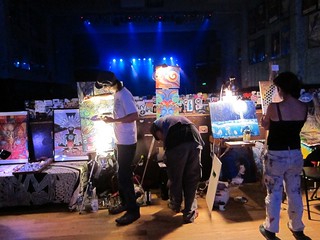

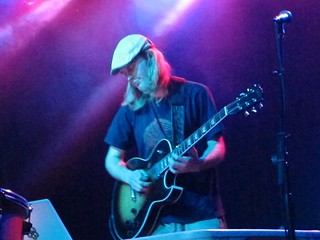
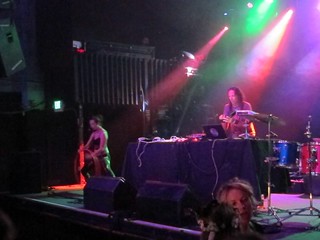
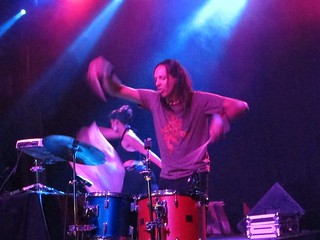
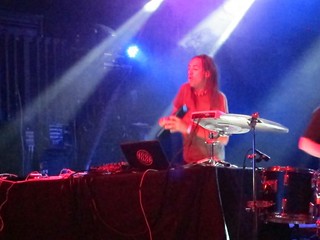

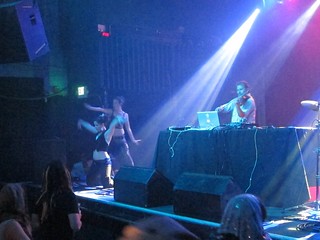
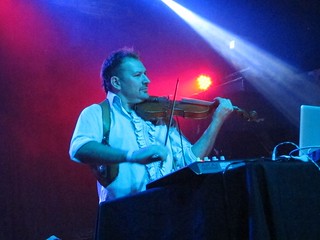
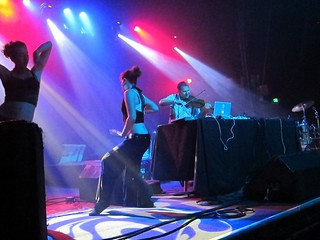
 Voyage of Exploration presents a fine collection of retro lounge/space music that imagines a much cooler future than our paltry dimension can offer. Like The Traditionalists, a branch of Secret Chiefs 3,
Voyage of Exploration presents a fine collection of retro lounge/space music that imagines a much cooler future than our paltry dimension can offer. Like The Traditionalists, a branch of Secret Chiefs 3,